MARIANI’SVirtual
Gourmet
July 13, 2014
NEWSLETTER
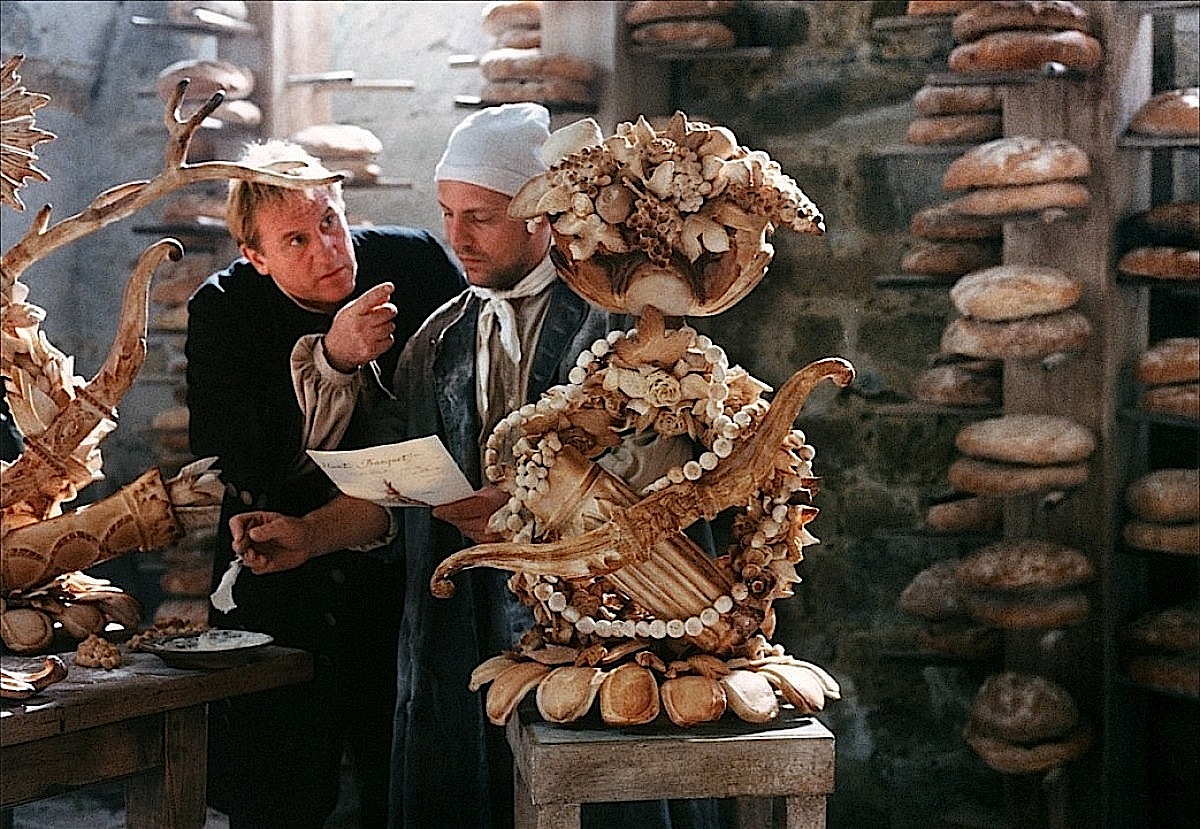
LET THEM EAT CAKE!
HAPPY BASTILLE DAY!
❖❖❖
IN THIS ISSUE
ROMAN HOLIDAY
By John Mariani
NEW YORK CORNER
HAVE DAVID CHANG AND APRIL BLOOMFIELD
REALLY CHANGED AMERICA?
By John Mariani
❖❖❖
ROMAN HOLIDAY
By John Mariani
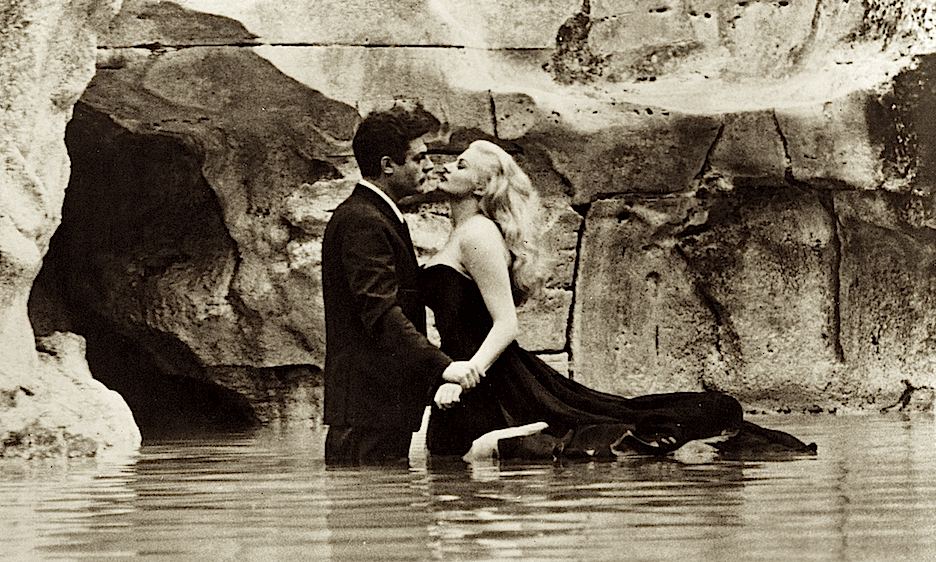
Marcello Mastroianni and Anita Ekberg in "La Dolce Vita" (1960)
Right
about now, Rome is overflowing with tourists glued
to guidebooks and iPhones, rather than actually
looking at the city’s grandeur, statues, churches
and paintings. The streets in and around St.
Peter’s will be thronged with tour groups
following leaders holding signs and flowers and
puppets, and they’ll all go to have a postcard
stamped at the Vatican Post Office.
The Spanish Steps will be littered
with both people and trash, while gawkers move
endlessly down the Via Condotti past the designer
fashion stores. The restaurants will start
seating people at 5 p.m., if such people are crazy
enough to eat that early, and the Roman nightclubs
will be pouring limoncello till four in the
morning.
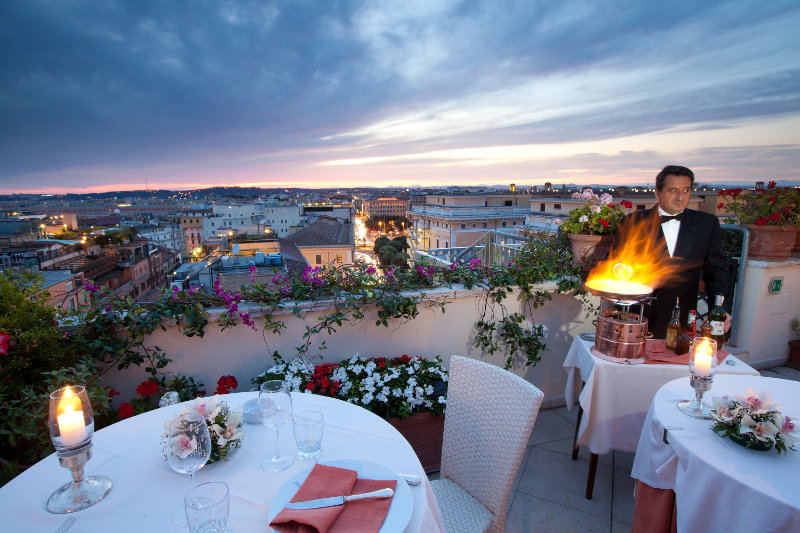 It’s just not
the time to go right now, mid-summer, and in August
most Romans close up shop and leave town. But,
if you can wait till after Labor Day or, as I did
this year, go in early spring, you may not have Rome
all to yourself, but it will seem more like a
civilized city than an amusement park.
It’s just not
the time to go right now, mid-summer, and in August
most Romans close up shop and leave town. But,
if you can wait till after Labor Day or, as I did
this year, go in early spring, you may not have Rome
all to yourself, but it will seem more like a
civilized city than an amusement park.
I actually had
only a couple of days in Rome this time, for I was
on may way to Campania, Basilicata and Apulia, but
landing at Rome’s now quite modern airport and
taking the easy-to-ride train straight into the
center of the city, arriving at the vast Railway
Terminal, was a way of simply renewing my affection
for the vast, sprawling city, whose streets seem to
obey no logic and whose monuments and churches and
piazzas are testaments to all those who occupied or
ruled over the city for the past two millennia.
My wife and I
checked into the historic Mediterraneo Hotel on the broad Via
Cavour, which is very conveniently just one block
from the Terminal. Built in 1936 by architect
Mario Loreti and set high on the Esquiline Hill, the
ten-story, 251-room (each individually decorated)
Mediterraneno is considered one of the finest of
Rome’s art déco hotels, motifs of which are
found throughout all the public rooms, staircase,
and drawing room.
The
first of two rooms my wife and I stayed in was in
that classic but dated-looking art deco style, the
furniture old and the fabrics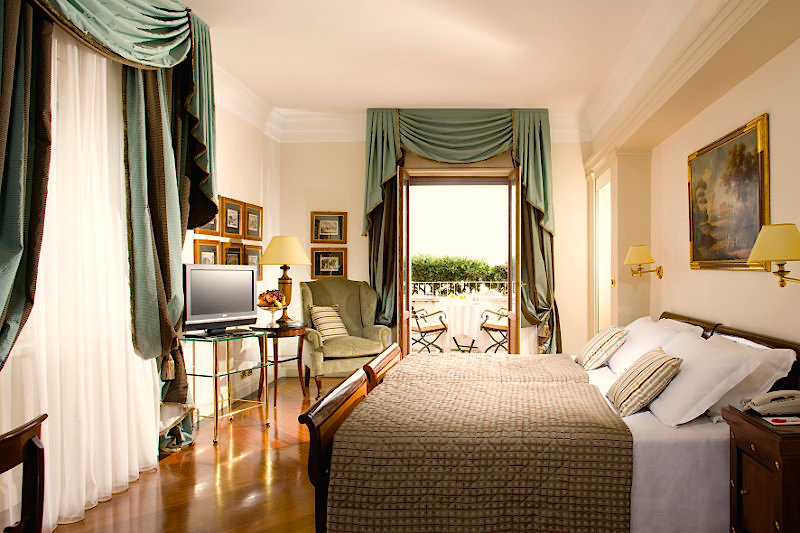 somewhat threadbare. I
much preferred the beautiful, more modern rooms (right) with a
contemporary Roman elegance in the furnishings, as
well as a glorious view of Rome from our balcony.
Free WiFi, installed just this spring, is available
throughout.
somewhat threadbare. I
much preferred the beautiful, more modern rooms (right) with a
contemporary Roman elegance in the furnishings, as
well as a glorious view of Rome from our balcony.
Free WiFi, installed just this spring, is available
throughout.
The hotel and the
smaller Massimo d’Azeglio Hotel right across the
street are both owned by the Bettoja family (as well
as the Hotel Atlantico and Hotel Nord), who have
maintained a critical balance between Roman
tradition and modernization. The Mediterraneo has a
rooftop restaurant (above) with a
large continental and Italian menu, and a
panorama view of the city best appreciated at
twilight. Some dishes, like king prawns flamed in
cognac, are prepared tableside. You may sample an
assortment of antipasti for €13. For pastas, I
recommend the rigatoni
alla
carbonara (with egg and guanciale
bacon) and the bucatini
cacio e pepe (cheese and black pepper),
both quintessential Roman dishes.
Downstairs they serve a
very lavish buffet breakfast in a room called the
Sala Taverna, decorated with Vetri ceramics.
The century-old
restaurant at the Massimo
d’Azeglio (below) has the refined look of
museum-quality artwork and furniture, with its
polished wood floors and wicker backed chairs, wood
wainscoting and glowing wall sconces, and
beautifully draped embossed pink linens. On
the wall hangs a 19th century painting of Count
Emilio Cavour, one of the key figures in Italy’s
Risorgimento.
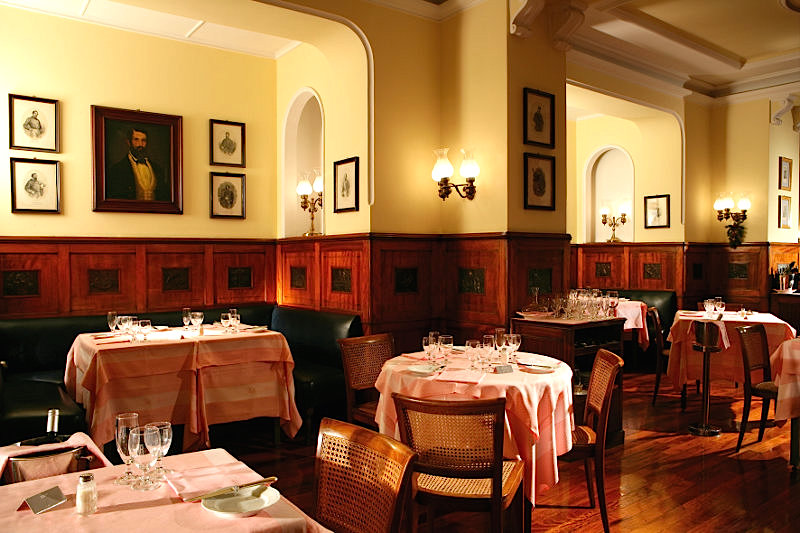 The modestly
priced menu is tilted more to Piedmont cuisine, with
specialties including meat ravioli with scallops
sauce; orecchiette
pasta with broccoli and ricotta cheese; tonnarelli with
seafood (€13); risotto with smoked provola cheese
and Speck (€12); crusted pork served with apple
sauce (€16), and--for a true Piedmontese feast--a gran bollito misto,
which is a rich amalgam of four or five meats boiled
in their own broth and served in two courses.
The modestly
priced menu is tilted more to Piedmont cuisine, with
specialties including meat ravioli with scallops
sauce; orecchiette
pasta with broccoli and ricotta cheese; tonnarelli with
seafood (€13); risotto with smoked provola cheese
and Speck (€12); crusted pork served with apple
sauce (€16), and--for a true Piedmontese feast--a gran bollito misto,
which is a rich amalgam of four or five meats boiled
in their own broth and served in two courses.
The wine list is solid,
with thousands of bottles, some uniquely rare,
dating back to the 1900s, and you may see for
yourself by organizing a private meal in the
cellar, surrounded by ancient stone archways,
old wine urns, candles, and rustic chairs and
tables set with red-and-white checkered tablecloths.
Ravenous
upon arriving in Rome, we headed for
Trastevere--“across the Tiber”--in search of the
kind of trattoria this old neighborhood,
with its winding streets and quiet passageways, has
plenty of. Two of those we sought out were
closed--you can never tell when this will be the
case in Rome--but happened upon the open door of
Hostaria da Corrado, now in its forty-fourth year
here, from which the aroma of good cooking issued
forth.
The cooks are two charming women
who have clearly perfected the few dishes they offer
each day, the tables are topped with paper, 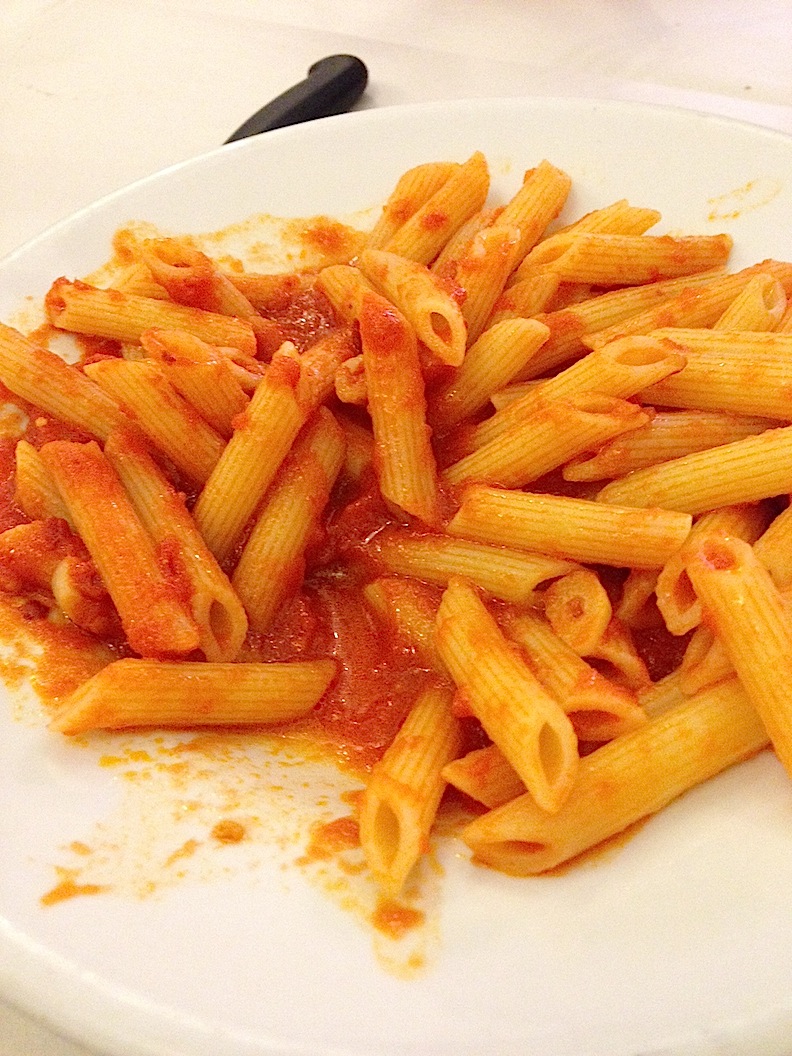 the wine comes by the half
or full liter, and the clientele are clearly locals,
including a good number of workmen who certainly
take more than an hour for lunch.
the wine comes by the half
or full liter, and the clientele are clearly locals,
including a good number of workmen who certainly
take more than an hour for lunch.
The cooking at da
Corrado was everything we wanted, especially so
because hunger demands satisfaction, not fuss.
There was no menu, so we just went with the
manager’s recommendations--fresh fettuccine al pomodoro
with a simple tomato sauce that showed up in other
seasoned versions on bucatini all’amatriciana (right), with
onions, pancetta
and pepperoncino, and all’arrabiata, pungent with chile
peppers. Ravioli were simply dressed with
butter, sage and pecorino cheese. We also enjoyed involtini rolls
of breaded pork, and excellent side dishes of
steamed chicory and broccoli.
On
the way out we gave effusive thanks to the chefs,
who seemed genuinely delighted we had stopped by to
eat their hearty Roman dishes. Lunch, for four
of us, with wine, was about $70. 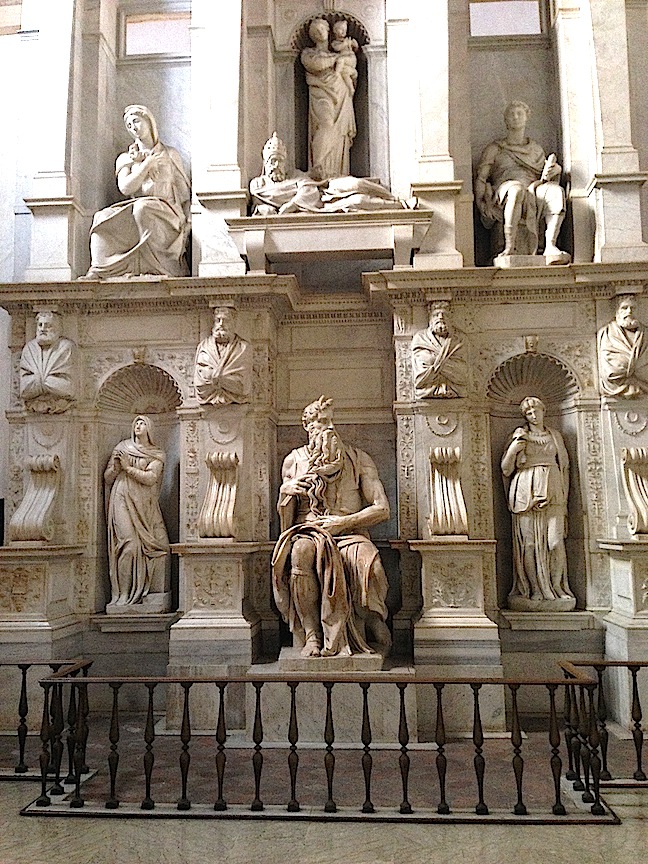 (Remember, it
is not necessary to tip at restaurants in Italy; a
service charge is included in the bill.)
(Remember, it
is not necessary to tip at restaurants in Italy; a
service charge is included in the bill.)
The
time we had to sight-see on our brief stay sent us
off to the nearby church San Pietro in Vincoli (“St.
Peter in Chains”), said to possess the very chains
with which Peter was imprisoned in Jerusalem.
But the real and magnificent reason to visit this
quiet basilica--well known but not much trafficked
by tourists in the morning--is the extraordinary
statue of Moses by Michelangelo, commissioned by
Pope Julius II in 1505 for his tomb, but not
completed until 1545, long after the pope
died. Holding onto the tablets of the Ten
Commandments, a powerful, angry Moses with a
voluptuously flowing beard looks sternly to his
left, and from his head spring what seem like two
horns, part of a legend that Moses brought the
tablets down from the mountain with his head glowing
with divine light.
The Moses is, with so much else
Michelangelo did in his long life, a masterpiece of
realism bursting with spirituality from the gentle
giant of a man with the visage of God himself.
❖❖❖
HAVE DAVID CHANG AND APRIL BLOOMFIELD
REALLY CHANGED AMERICA?
By John Mariani
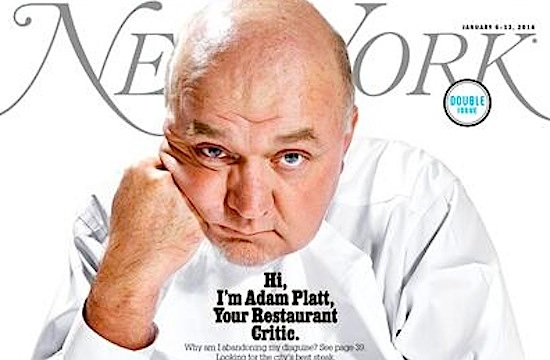 My
admiration for the work of New York
chef/restaurateurs David Chang and others and April Bloomfield
is exceeded only by that for New York
magazine’s restaurant critic Adam Platt, whom I
consider the best in the New York media and who this
past week wrote an article entitled “The Chefs That
Changed America: A Decade of David Chang and April
Bloomfield.”
My
admiration for the work of New York
chef/restaurateurs David Chang and others and April Bloomfield
is exceeded only by that for New York
magazine’s restaurant critic Adam Platt, whom I
consider the best in the New York media and who this
past week wrote an article entitled “The Chefs That
Changed America: A Decade of David Chang and April
Bloomfield.”Knowing that editors usually write the titillating titles for authors’ articles, I shall take the hyperbole with a grain of salt, although Platt does say that, despite the importance of New York restaurants like Thomas Keller’s Per Se, Dan Barber’s Blue Hill at Stone Barns (in Tarrytown, N.Y.), Masa
 Takayama’s
Masa and Danny Meyer’s Shake Shack, “none of these
landmark establishments ended up being quite as
influential, or as subtly subversive, as Chang’s
original Noodle Bar or Bloomfield and Friedman's
snug, unassuming little pub,” The Spotted Pig, all
opened in 2004.
Takayama’s
Masa and Danny Meyer’s Shake Shack, “none of these
landmark establishments ended up being quite as
influential, or as subtly subversive, as Chang’s
original Noodle Bar or Bloomfield and Friedman's
snug, unassuming little pub,” The Spotted Pig, all
opened in 2004.Platt credits Chang (right), who owns Momofuko Ko and several others, and Bloomfield, who owns The Spotted Pig and The Breslin, for causing restaurants to “grow smaller [and] louder,” the food “heartier and heavier.” They were “the first to break down the age-old barriers between the front and the back of the house and to officially introduce the kitchen culture (tattoos, hip-hop in the dining room, pork belly)
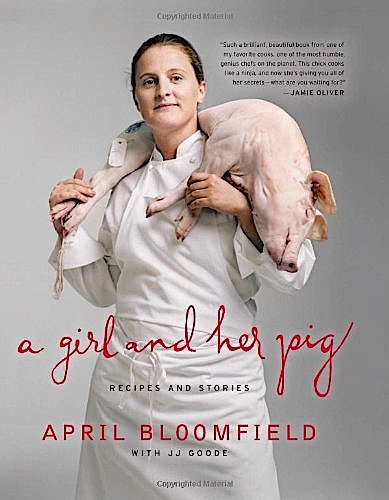 that had been
hiding until then, in the shadows, to a new
generation of eaters.” He credits--if that is the
word-- the two with creating byzantine reservation
policies, or taking none at all, and, in
Bloomfield’s case, for pioneering the gastro
pub. Platt even goes so far as to contend that
because of Chang's and Bloomfield's massive media
exposure many of America’s best chefs “felt
empowered to follow their own tastes and instincts,
rather than endlessly repeat the lessons of the
grand French masters.”
that had been
hiding until then, in the shadows, to a new
generation of eaters.” He credits--if that is the
word-- the two with creating byzantine reservation
policies, or taking none at all, and, in
Bloomfield’s case, for pioneering the gastro
pub. Platt even goes so far as to contend that
because of Chang's and Bloomfield's massive media
exposure many of America’s best chefs “felt
empowered to follow their own tastes and instincts,
rather than endlessly repeat the lessons of the
grand French masters.”He sums up his hyperboles by writing: “You can thank them for a food world that’s more democratic, more accessible, and generally a whole lot more fun than the one these two young cooks, coming from different worlds, stumbled into, ten long years ago, in the summer of 2004.”
Now some of Platt’s assertions have weight, but the gorilla-like domination he awards Chang and Bloomfield really has more to do with the power of the New York media, the same ones who coined the fatuous word “Brooklyn-ization” to describe how chefs and restaurateurs in Chicago, Los Angeles, San Francisco and Houston suddenly fell over themselves to copy a handful of Brooklyn restaurants’ brick wall décor, ear-splitting playlists, and tasting menus-only policy. Which was nonsense.
Of course, the New York food media often exalted novelty for its own sake, because that’s what news media do, and it was their myopia--having rarely eaten anywhere else but New York--that caused them to credit local chefs with every advance in American gastronomy over the past decade. Those who do not learn from restaurant history are bound to inflate it.
Chang’s “pre-ordered fried chicken dinners” are exalted by those who’ve never eaten fried chicken in New Orleans (like the one shown at right from Willie Mae Scotch House) or Nashville or Kansas
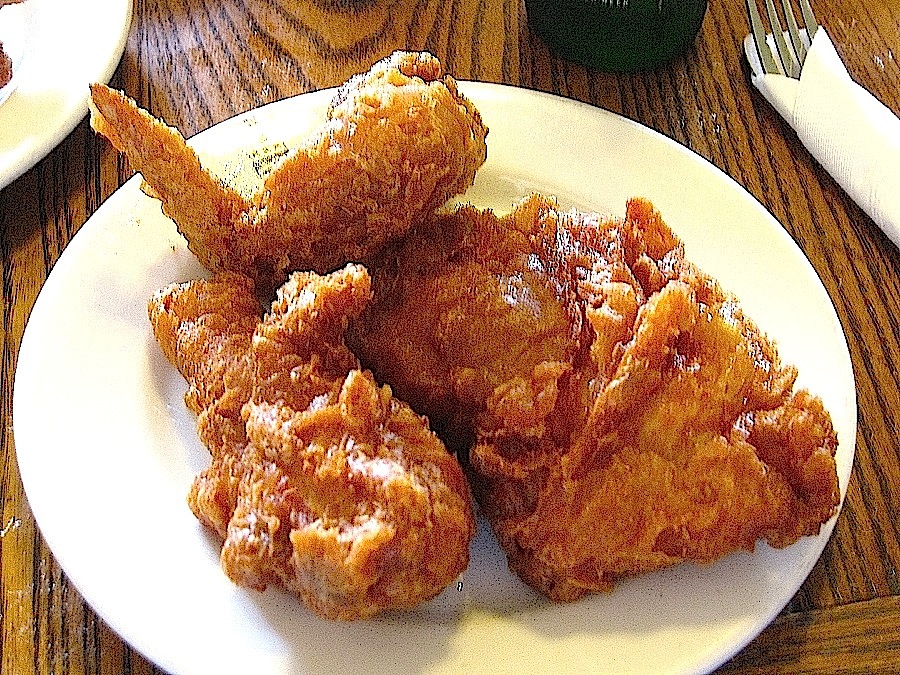 City.
His steamed buns are considered epiphanies, without
critics sampling the best in New York’s Chinatown--a
neighborhood the media almost totally ignores. The
same goes for Bloomfield serving pork belly, which
Chinese restaurants have always had on their menus.
City.
His steamed buns are considered epiphanies, without
critics sampling the best in New York’s Chinatown--a
neighborhood the media almost totally ignores. The
same goes for Bloomfield serving pork belly, which
Chinese restaurants have always had on their menus.I’m not sure what to make of Platt’s insistence that Chang and Bloomfield made food “heartier and heavier,” when anyone seeking out just that kind of fare could go to hundreds of Italian, Thai, Indian and other ethnic restaurants all over the city. Think of the food at Mario Batali’s Babbo and you’ve got the idea.
Nor did Chang's and Bloomfield's chefs “empower” (the trendiest word of the decade) chefs to stop “endlessly repeat[ing] the lessons of the
grand French masters.” In fact, by 2004, chefs like Jean-Georges
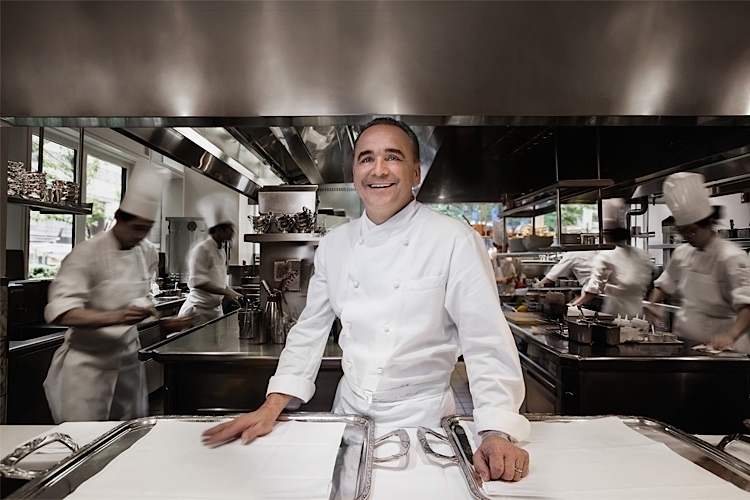 Vongerichten
(left) of
Jean-Georges, the late Gilbert LeCoze of Le
Bernardin, Gray Kunz of Lespinasse, and David Bouley
of Bouley had long before shaken up the rigidity of
French haute cuisine, and that direction is as
strong today as it was then. Vongerichten also
created Spice Market in 2004--big (not small), loud,
and with a menu of Southeast Asian street food that
includes spicy Thai fried chicken wings with mango
and mint-- which didn’t need to be pre-ordered.
Vongerichten
(left) of
Jean-Georges, the late Gilbert LeCoze of Le
Bernardin, Gray Kunz of Lespinasse, and David Bouley
of Bouley had long before shaken up the rigidity of
French haute cuisine, and that direction is as
strong today as it was then. Vongerichten also
created Spice Market in 2004--big (not small), loud,
and with a menu of Southeast Asian street food that
includes spicy Thai fried chicken wings with mango
and mint-- which didn’t need to be pre-ordered.Was Bloomfield’s modest Spotted Pig--bankrolled by Mario Batali, who brought in a high-profile celebrity crowd to a tiny space only they could get easy access to--the first gastro pub? By no means; the word gastro pub itself has been in print since 1996, to describe modern London pubs like The Eagle and the Lansdowne, which by then were serving menus well beyond shepherd’s pie and bangers and mash.
Back in 1989, I co-authored a restaurant guide to New York and could hardly keep up with the myriad new hot spots making waves as part
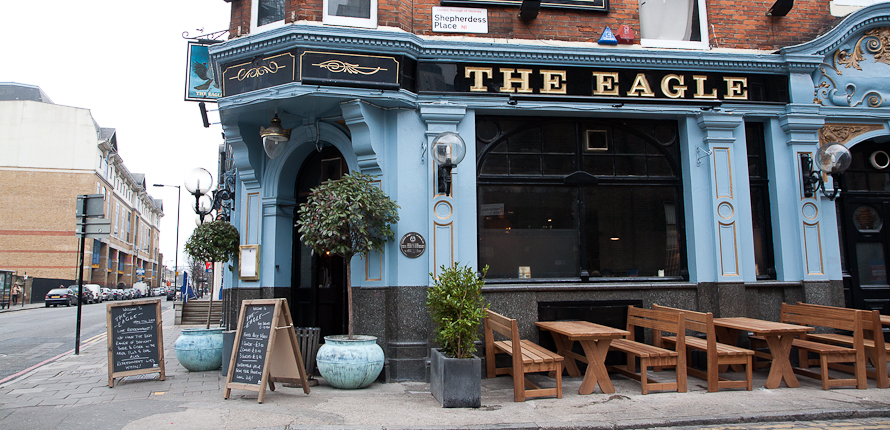 of the rapid evolution of
the city’s food culture. There was the Odeon
in Tribeca and Balthazar in Soho, opened by Keith
McNally, one of the smartest innovators in the
business; Montrachet, opened by another pioneer,
Drew Nieporent (below);
Da Silvano and Il Cantinori, which kicked off the
Tuscan trattoria trend; Gotham Bar & Grill,
still an iconic New York restaurant, with a chef’s
chef, Alfred Portale; a grunge French bistro named
Florent in the Meat Packing District; Danny Meyer’s
Union
of the rapid evolution of
the city’s food culture. There was the Odeon
in Tribeca and Balthazar in Soho, opened by Keith
McNally, one of the smartest innovators in the
business; Montrachet, opened by another pioneer,
Drew Nieporent (below);
Da Silvano and Il Cantinori, which kicked off the
Tuscan trattoria trend; Gotham Bar & Grill,
still an iconic New York restaurant, with a chef’s
chef, Alfred Portale; a grunge French bistro named
Florent in the Meat Packing District; Danny Meyer’s
Union 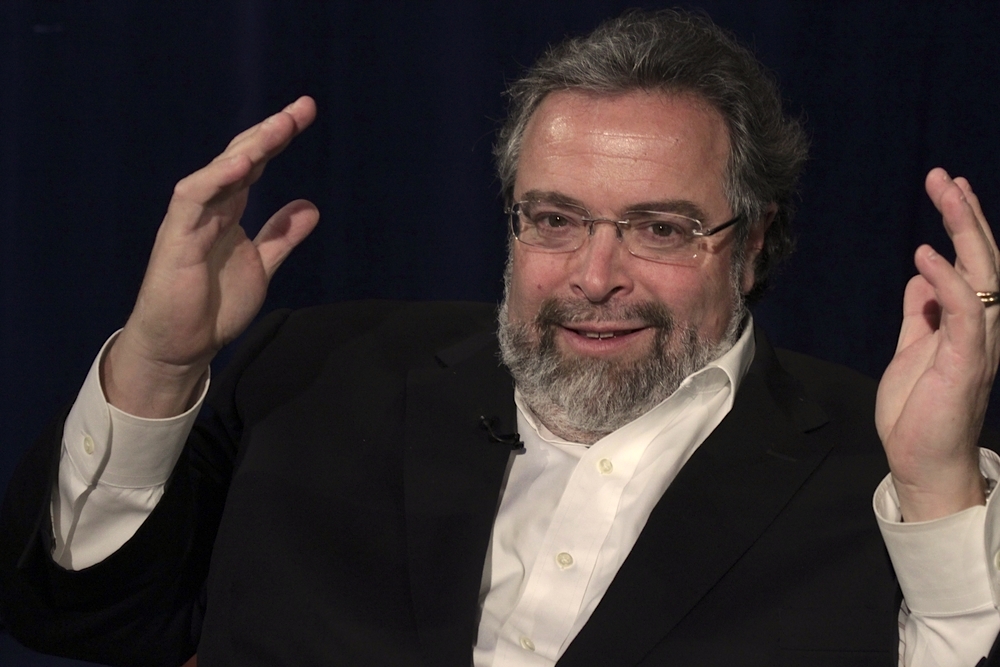 Square Café, whose
new style of cordiality changed everything about
American hospitality; the beloved art déco
Empire Diner, small, loud, with a counter just like
Chang’s Momofuko Ko. There were many more--all of
them downtown, long before Chang and Bloomfield made
that area hip.
Square Café, whose
new style of cordiality changed everything about
American hospitality; the beloved art déco
Empire Diner, small, loud, with a counter just like
Chang’s Momofuko Ko. There were many more--all of
them downtown, long before Chang and Bloomfield made
that area hip.The same vanguard spirit should also be credited to young chefs and restaurateurs in other parts of the country working long before Chang and Bloomfield arrived on the scene: Guillermo Pernot, who spearheaded the arrival of modern Latino food at ¡Pasión! in Philadelphia; Mavro Thalassitis, who did the same for Hawaiian-French cuisine at Chef Mavro in Honolulu, and Donald Link for modern Creole at Herbsaint and American charcuterie at Cochon; Michelle Bernstein, who created a wondrous Florida-Caribbean style at Azul in Miami; Ming Tsai, who contemporized Chinese food at Blue Ginger in Wellesley, Mass.; José Andres (below), who brought Spain’s molecular gastronomy to the U.S. at minibar in D.C.; and no one has
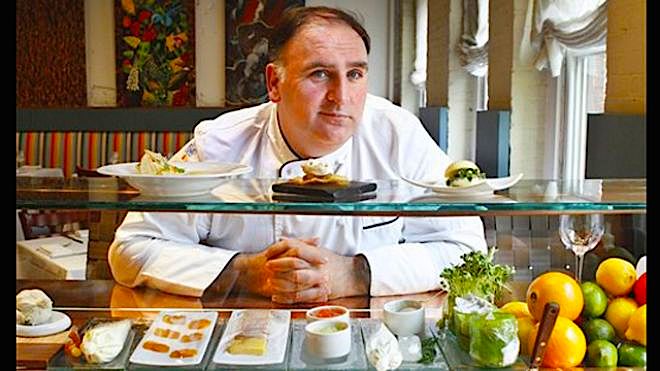 had more of an effect on
Japanese food that Nobu Matsuhisa, whose original
sushi bar was in Los Angeles, before he opened his
namesake restaurant to New York.
had more of an effect on
Japanese food that Nobu Matsuhisa, whose original
sushi bar was in Los Angeles, before he opened his
namesake restaurant to New York. I am not trying to suggest that Chang and Bloomfield have not had considerable influence on American gastronomy, but both have been hyped by the New York media all out of whack with the reality of what goes on in the rest of the United States. It's interesting to note that neither Chang nor Bloomfield ever made such claims for themselves, and Chang once said that when working for others, he always thought he was the worst cook on the line.
While it is easy enough to make a case for the explosive mark music groups like the Sex Pistols and Nirvana made in their time, it would be difficult to compare their influence on contemporary music with that made by hip hop artists like Jay-Z, rockers like Bruce Springsteen, the concept albums of Paul Simon, and the jazz soul of Alicia Keys.
As ever, time will tell about Chang and Bloomfield--two excellent, innovative chefs and canny restaurateurs--but did they actually “change
America?” No, but they are a respected part of what makes America’s culinary culture the most fascinating in the world right now.
❖❖❖
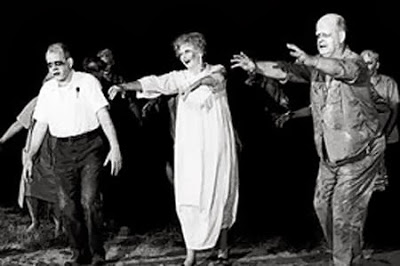
Fifteen employees at Austin, TX,
restaurant Qui agreed to get a tattoo exactly like
their boss's, chef Paul Qui

STORIES ABOUT
IDIOTS WE
JUST DON'T
WHOLLY BELIEVE
New Jersey cardiologist Zyad Younan spent $135,000 on his credit card at Scores gentleman's club in NYC but claimed he was drugged by strippers there. Scores denied the claim, telling the NY Post, Younan "spent a lot of money. . . We have it on tape. Within two weeks he was here four times. So if he was drugged the first time, I guess he liked it."
Any of John Mariani's
books below may be ordered from amazon.com.
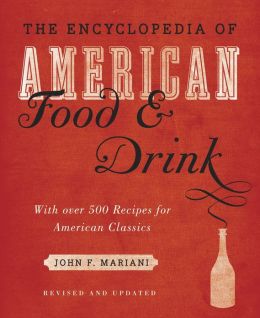 |
The Encyclopedia of American Food and Drink by John F. Mariani (Bloomsbury USA, $35) Modesty forbids me to praise my own new book, but let me proudly say that it is an extensive revision of the 4th edition that appeared more than a decade ago, before locavores, molecular cuisine, modernist cuisine, the Food Network and so much more, now included. Word origins have been completely updated, as have per capita consumption and production stats. Most important, for the first time since publication in the 1980s, the book includes more than 100 biographies of Americans who have changed the way we cook, eat and drink -- from Fannie Farmer and Julia Child to Robert Mondavi and Thomas Keller. "This book is amazing! It has entries for everything from `abalone' to `zwieback,' plus more than 500 recipes for classic American dishes and drinks."--Devra First, The Boston Globe. "Much needed in any kitchen library."--Bon Appetit. |
"Eating Italian will never be the same after reading John Mariani's entertaining and savory gastronomical history of the cuisine of Italy and how it won over appetites worldwide. . . . This book is such a tasteful narrative that it will literally make you hungry for Italian food and arouse your appetite for gastronomical history."--Don Oldenburg, USA Today. "Italian
restaurants--some good, some glitzy--far
outnumber their French rivals. Many of
these establishments are zestfully described
in How Italian Food Conquered the World, an
entertaining and fact-filled chronicle by
food-and-wine correspondent John F.
Mariani."--Aram Bakshian Jr., Wall Street
Journal.
"Equal parts
history, sociology, gastronomy, and just
plain fun, How Italian Food Conquered the
World tells the captivating and delicious
story of the (let's face it) everybody's
favorite cuisine with clarity, verve and
more than one surprise."--Colman Andrews,
editorial director of The Daily
Meal.com. "A fantastic and fascinating
read, covering everything from the influence
of Venice's spice trade to the impact of
Italian immigrants in America and the
evolution of alta cucina. This book will
serve as a terrific resource to anyone
interested in the real story of Italian
food."--Mary Ann Esposito, host of PBS-TV's
Ciao
Italia. "John Mariani has written the
definitive history of how Italians won their
way into our hearts, minds, and
stomachs. It's a story of pleasure over
pomp and taste over technique."--Danny Meyer,
owner of NYC restaurants Union Square
Cafe, The Modern, and Maialino.
|
 |
 |
 |
 |
 |
 |
 |
 |
 Everett Potter's Travel Report:
Everett Potter's Travel Report: 
 Eating Las Vegas
is the new on-line site for Virtual Gourmet
contributor John A. Curtas., who since 1995
has been commenting on the Las Vegas food
scene and reviewing restaurants for Nevada
Public Radio. He is also the
restaurant critic for KLAS TV, Channel 8 in
Las Vegas, and his past reviews can be
accessed at KNPR.org.
Click on the logo below to go directly to
his site.
Eating Las Vegas
is the new on-line site for Virtual Gourmet
contributor John A. Curtas., who since 1995
has been commenting on the Las Vegas food
scene and reviewing restaurants for Nevada
Public Radio. He is also the
restaurant critic for KLAS TV, Channel 8 in
Las Vegas, and his past reviews can be
accessed at KNPR.org.
Click on the logo below to go directly to
his site.

Tennis Resorts Online: A Critical Guide to the World's Best Tennis Resorts and Tennis Camps, published by ROGER COX, who has spent more than two decades writing about tennis travel, including a 17-year stretch for Tennis magazine. He has also written for Arthur Frommer's Budget Travel, New York Magazine, Travel & Leisure, Esquire, Money, USTA Magazine, Men's Journal, and The Robb Report. He has authored two books-The World's Best Tennis Vacations (Stephen Greene Press/Viking Penguin, 1990) and The Best Places to Stay in the Rockies (Houghton Mifflin, 1992 & 1994), and the Melbourne (Australia) chapter to the Wall Street Journal Business Guide to Cities of the Pacific Rim (Fodor's Travel Guides, 1991).


MARIANI'S VIRTUAL GOURMET
NEWSLETTER is published weekly. Editor/Publisher: John
Mariani.
Editor: Walter Bagley. Contributing Writers: Christopher Mariani,
Robert Mariani, John A.
Curtas, Edward Brivio, Mort Hochstein, Suzanne
Wright, and Brian Freedman. Contributing
Photographers: Galina Stepanoff-Dargery,
Bobby Pirillo. Technical Advisor: Gerry McLoughlin.
To un-subscribe from this newsletter,click here.
© copyright John Mariani 2014
